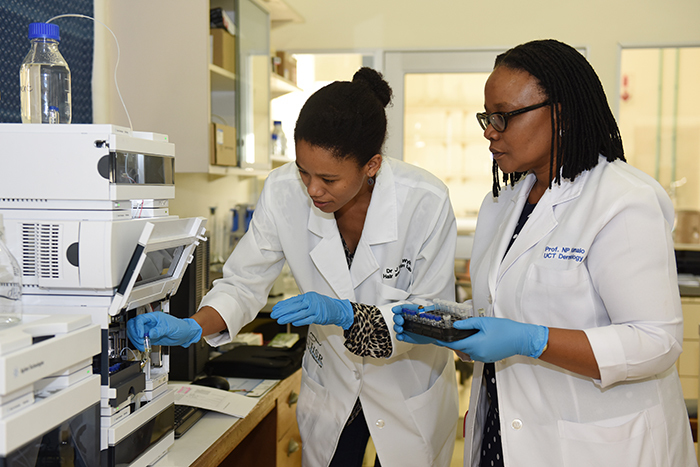Dangerous skin lightening products on sale on our streets
31 August 2015 | Story by Newsroom
Even though South Africa has some of the toughest laws against skin lighteners, many international products containing dangerous and illegal substances are still being sold in Cape Town, a UCT study has found.
The study, published recently in the journal Clinical and Experimental Dermatology calls for tighter import regulations and random testing to protect consumers.
In spite of a ban on the sale of over-the-counter cosmetic products containing ingredients such as mercury, topical steroids and hydroquinone, the study found an alarming trend in the composition of internationally manufactured skin lightening products available for sale in Cape Town.
Said study leader Professor Nonhlanhla Khumalo, head of dermatology at UCT and Groote Schuur Hospital: "Not only did almost 80% of the products tested contain illegal or banned ingredients, we discovered that many products combined more than one illegal ingredient."
Conducted in 2013, by clinicians from Groote Schuur Hospital and a multidisciplinary team of academic scientists, the study investigated active ingredients and countries of origin of popular skin-lightening products available in Cape Town.
Of the 29 products tested, 22 were found to contain illegal ingredients. All 22 were imported products and were obtained from informal vendors. And in spite of a European Union ban on skin lightners, a third of the tested products originated from Europe.
Hydroquinone has long been the leading offender but the results of this study suggest that potent and ultra-potent topical steroids, in combination with mercury, have become the leading ingredients in skin-lightening products. Most (76.9%) of the 13 products containing steroids were combined with either mercury or hydroquinone or both.
Devastating, harmful effects
The devastating and, at times, irreversible harmful effects associated with the use of skin-lightening cosmetics containing mercury and hydroquinone are well established. By including topical steroids in the preparation, which increases absorption through the skin along with these hazardous substances, consumers are exposed to greater risks than before.
The high incidence of prescription-strength topical steroids in the tested products was a concern, the authors said, and corroborated recent reports of increased steroid-induced cutaneous side effects from Durban, South Africa.
Another area of concern was the importation of clearly labelled, ultra-potent steroids as cosmetics as some of the products declared the presence of clobetasol propionate (CP) and betamethasone (BM) on the label.
Researchers cited attractive packaging as a possible reason for this, highlighting the need for greater education about the identification of and knowledge about ingredients and their effects.
Highly potent topical steroids are typically prescribed for the short-term treatment of severe skin diseases: however, their use on normal skin increases the risk of glaucoma, cataracts, acne, skin atrophy and infections.
"The top three countries of origin of the tested products were Italy (6), India (5) and Democratic Republic of Congo (5), which raises questions about whether South Africa has become a dumping ground for illegal cosmetics," said Khumalo. "We recommend improved international law enforcement and random testing to encourage industry compliance and help protect customers."
*Khumalo recently launched the first Hair and Skin Research Laboratory (HSR Lab) locally and internationally to focus on comprehensive hair testing and safety in cosmetic formulation.
 This work is licensed under a Creative Commons Attribution-NoDerivatives 4.0 International License.
This work is licensed under a Creative Commons Attribution-NoDerivatives 4.0 International License.
Please view the republishing articles page for more information.










